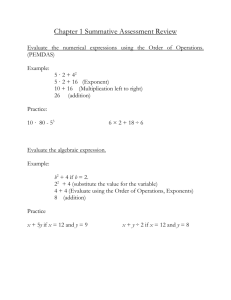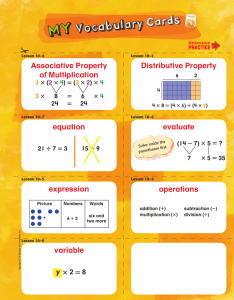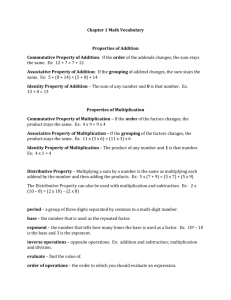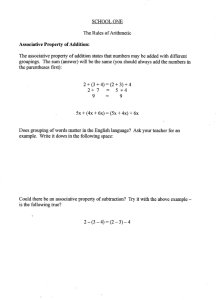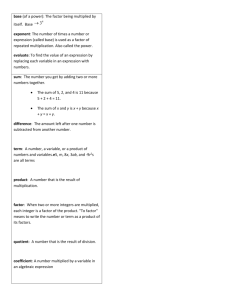Unit 7: Applying Multiplication and Division Facts and Strategies
advertisement
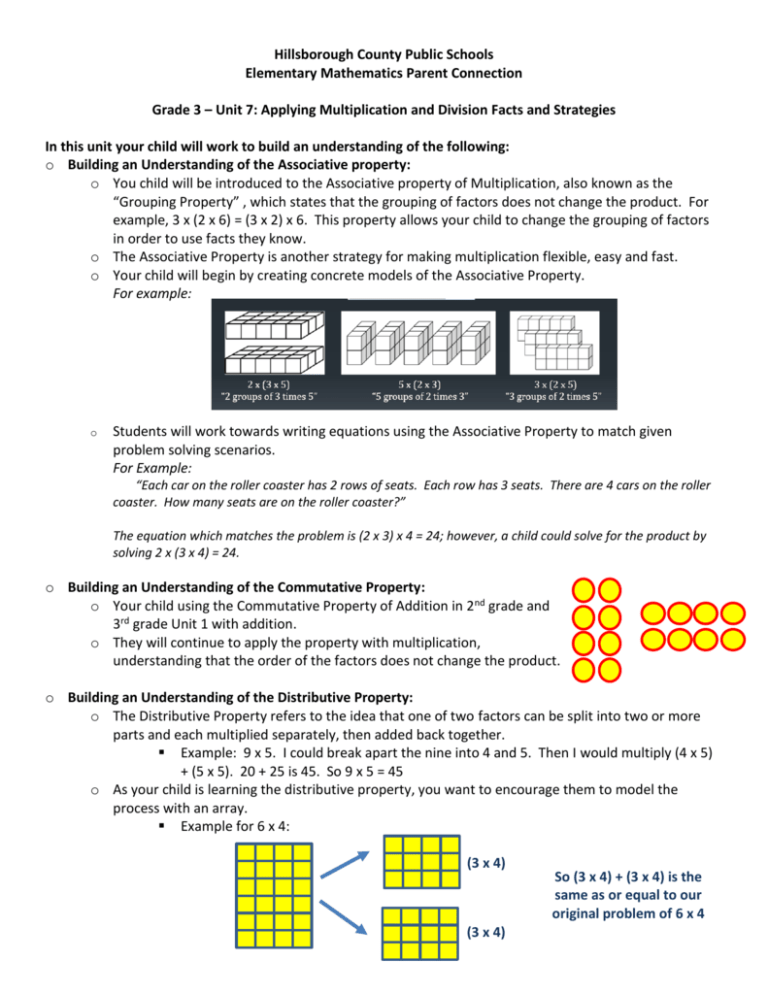
Hillsborough County Public Schools Elementary Mathematics Parent Connection Grade 3 – Unit 7: Applying Multiplication and Division Facts and Strategies In this unit your child will work to build an understanding of the following: o Building an Understanding of the Associative property: o You child will be introduced to the Associative property of Multiplication, also known as the “Grouping Property” , which states that the grouping of factors does not change the product. For example, 3 x (2 x 6) = (3 x 2) x 6. This property allows your child to change the grouping of factors in order to use facts they know. o The Associative Property is another strategy for making multiplication flexible, easy and fast. o Your child will begin by creating concrete models of the Associative Property. For example: o Students will work towards writing equations using the Associative Property to match given problem solving scenarios. For Example: “Each car on the roller coaster has 2 rows of seats. Each row has 3 seats. There are 4 cars on the roller coaster. How many seats are on the roller coaster?” The equation which matches the problem is (2 x 3) x 4 = 24; however, a child could solve for the product by solving 2 x (3 x 4) = 24. o Building an Understanding of the Commutative Property: o Your child using the Commutative Property of Addition in 2nd grade and 3rd grade Unit 1 with addition. o They will continue to apply the property with multiplication, understanding that the order of the factors does not change the product. o Building an Understanding of the Distributive Property: o The Distributive Property refers to the idea that one of two factors can be split into two or more parts and each multiplied separately, then added back together. Example: 9 x 5. I could break apart the nine into 4 and 5. Then I would multiply (4 x 5) + (5 x 5). 20 + 25 is 45. So 9 x 5 = 45 o As your child is learning the distributive property, you want to encourage them to model the process with an array. Example for 6 x 4: (3 x 4) (3 x 4) So (3 x 4) + (3 x 4) is the same as or equal to our original problem of 6 x 4 o Apply Strategies for Making Sense of Story Problems: o Your child will explore a variety of strategies to help them make sense of mutli-step problem solving scenarios, such as making a table to organize information, or using a graphic organizer, such as the K-W-P-L shown at below. o Students will write equations to match multi-step story problems, as well as write multi-step problems for a given equation. For Example: A student given the equation 5 x 2 + m = 25 might write the scenario, “Teresa gave 5 of her friends each 2 friendship bracelets, and she also gave some to her sister. She started with 25 bracelets. How many did she give to her sister?” Check out the “Parent Quick Smarts” video by scanning the QR code or using the Internet link provided. Other Helpful Links: http://wwwk6.thinkcentral.com/content/hsp/math/hspmath/na/common/me ga_math_9780547585062_/megamathcd5/cm/launch.html?strActi vityName=g36_2_4_D&strAssignID=1 – students interpret and apply the strategy of “Make a Table” http://youtu.be/KOL05t7w5DM Sample tasks your child should be able to work through by the end of the unit: On Saturday, Kelly made $3 for each room she vacuumed at her Grandma’s house. She rewarded herself for all her hard work and bought a $2 ice cream cone on the way home. If Kelly vacuumed all 7 rooms in her Grandma’s house, how much money did she have when she got home? Use the order of operations to solve the equation below: 6 +5 x 2 = x Write an equation to match the story, and then solve. Purposeful Practice you and your child may work on at home together. o Use everyday items (cereal, toys, pennies, etc) to make equal groups of arrays, then write an expression that matches the model. Apply the Associative Property of Multiplication to find other expressions that would have the same product. Prove they have the same product using the items. o Pose a two-step story problem to your child. Ask them to write an equation to match the story problem. Ask them questions such as: o Why did you choose that operation? o What does the variable represent from the problem? o Give your student an equation with one or two operations and challenge them to write a story problem that would match the equation.


